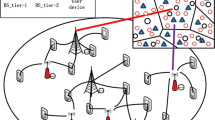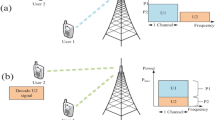Abstract
Nowadays, the application of data caching in mobile edge computing networks is exponentially increasing as a high-speed data storage layer using deep learning (DL) approaches. This paper presents an DL-based resource allocation approach to find the optimal topology for cache-enabled backhaul networks. In the practical scenarios, a numerous of radial configurations of test systems have been applied for training stages. This paper also applied the continuation power flow analysis to achieve the maximum load limit in which the power of macro base stations with the caches of different sizes is provided through either smart grid network or renewable power systems. To increase the power efficiency index of this approach the power sharing capability was enabled among different layer of network components through smart grids. In order to obtain the optimal solution, the DL-based mathematical problem is reformulated into a neural weighting model considering convergence conditions and Lyapunov stability of the mobile-edge-computing under Karush–Kuhn–Tucker optimality constraints. The mathematical analysis and simulation results demonstrate that the performance of the proposed algorithm is better than other energy efficiency algorithms. The proposed approach can effectively increase the total system throughput and network’s utility in addition to guarantee user fairness index.










Similar content being viewed by others
References
Zhou, H., Wang, H., Li, X., & Leung, V. C. M. (2018). A survey on mobile data offloading technologies. IEEE Access, 6, 5101–5111.
Mohajer, A., Bavaghar, M., & Farrokhi, H. (2020). Reliability and Mobility Load Balancing in Next Generation Self-organized Networks: Using Stochastic Learning Automata. Wireless Personal Communications, 114(3), 2389–2415.
Mohajer, A., Barari, M., & Zarrabi, H. (2016). QoSCM: QoS-aware coded multicast approach for wireless networks. KSII Transactions on Internet and Information Systems (TIIS), 10(12), 5191–5211.
Liu, L., Zhou, Y., Yuan, J., Zhuang, W., & Wang, Y. (2019). Economically optimal MS association for multimedia content delivery in cache-enabled heterogeneous cloud radio access networks. IEEE Journal on Selected Areas in Communications, 37(7), 1584–1593.
Somarin, A. M., Alaei, Y., Tahernezhad, M. R., Mohajer, A., & Barari, M. (2015). An efficient routing protocol for discovering the optimum path in mobile ad hoc networks. Indian Journal of Science and Technology, 8(S8), 450–455.
Smith, J. M. (2018). Open Queueing Network Algorithms $$ f {\bigl (G (V, E)\bigr)} $$. In Introduction to Queueing Networks (pp. 181–259). Springer, Cham
Zhang, Ke., Leng, S., He, Y., Maharjan, S., & Zhang, Y. (2018). Cooperative content caching in 5G networks with mobile edge computing. IEEE Wireless Communications, 25(3), 80–87.
Ghosh, A., Chakraborty, B., Raha, A., & Mukherjee, A. (2021). Improving Network Throughput by Hardware Realization of a Dynamic Content Caching Scheme for Information-Centric Networking (ICN). Wireless Personal Communications, 116(4), 2873–2898.
Mohajer, A., Barari, M., & Zarrabi, H. (2017). Big data based self-optimization networking: A novel approach beyond cognition. Intelligent Automation & Soft Computing, 1, 1–7.
Nikjoo, F., Mirzaei, A., & Mohajer, A. (2018). A novel approach to efficient resource allocation in NOMA heterogeneous networks: Multi-criteria green resource management. Applied Artificial Intelligence, 32(7–8), 583–612.
Tran, T. X., & Pompili, D. (2018). Joint task offloading and resource allocation for multi-server mobile-edge computing networks. IEEE Transactions on Vehicular Technology, 68(1), 856–868.
Wang, J., Wenbing, W., Zhuofan Liao, R., Sherratt, S., Kim, G.-J., Alfarraj, O., Alzubi, A., & Tolba, A. (2020). A probability preferred priori offloading mechanism in mobile edge computing. IEEE Access, 8, 39758–39767.
Mohajer, A., Bavaghar, M., Saboor, R., & Payandeh, A. (2013). Secure dominating set-based routing protocol in MANET: Using reputation. In 2013 10th International ISC Conference on Information Security and Cryptology (ISCISC) (pp. 1–7). IEEE.
Mohajer, A., Hajimobini, M. H., Mirzaei, A., & Noori, E. (2014). Trusted-CDS based intrusion detection system in wireless sensor network (TC-IDS). Open Access Library Journal, 1(7), 1–10.
Kiranyaz, S., Ince, T., Yildirim, A., & Gabbouj, M. (2009). Evolutionary artificial neural networks by multi-dimensional particle swarm optimization. Neural networks, 22(10), 1448–1462.
Rao, R. S., Narasimham, S. V. L., Raju, M. R., & Srinivasa Rao, A. (2010). Optimal network reconfiguration of large-scale distribution system using harmony search algorithm. IEEE Transactions on Power Systems, 26(3), 1080–1088.
Wang, J., Osagie, E., Thulasiraman, P., & Thulasiram, R. K. (2009). HOPNET: A hybrid ant colony optimization routing algorithm for mobile ad hoc network. Ad Hoc Networks, 7(4), 690–705.
Fricker, C., Robert, P., Roberts, J., & Sbihi, N. (2012). Impact of traffic mix on caching performance in a content-centric network. In 2012 Proceedings IEEE INFOCOM Workshops (pp. 310–315). IEEE.
Huang, B., Liu, A., Zhang, C., Xiong, N., Zeng, Z., & Cai, Z. (2018). Caching joint shortcut routing to improve quality of service for information-centric networking. Sensors, 18(6), 1750.
Mohajer, A., Barari, M., & Zarrabi, H. (2016). Big Data-based Self Optimization Networking in Multi Carrier Mobile Networks. Bulletin de la Société Royale des Sciences de Liège, 85, 392–408.
Mohajer, A., Somarin, A., Yaghoobzadeh, M., & Gudakahriz, S. (2016). A method based on data mining for detection of intrusion in distributed databases. Journal Of Engineering And Applied Sciences, 11(7), 1493–1501.
Lin, P., Song, Q., Yao, Yu., & Jamalipour, A. (2017). Extensive cooperative caching in D2D integrated cellular networks. IEEE Communications Letters, 21(9), 2101–2104.
Farooq, M. J., Ghazzai, H., Kadri, A., ElSawy, H., & Alouini, M.-S. (2016). Energy sharing framework for microgrid-powered cellular base stations. In 2016 IEEE Global Communications Conference (GLOBECOM) (pp. 1–7). IEEE.
Piovesan, N., Temesgene, D. A., Miozzo, M., & Dini, P. (2009). Joint load control and energy sharing for autonomous operation of 5g mobile networks in micro-grids. IEEE Access, 7, 31140–31150.
Rahimi, A. M., Ziaeddini, A., & Gonglee, S. (2021). A novel approach to efficient resource allocation in load-balanced cellular networks using hierarchical DRL. Journal of Ambient Intelligence and Humanized Computing, 1, 1–15.
Mohajer, A., Yousefvand, M., Ghalenoo, E. N., Mirzaei, P., & Zamani, A. (2014). Novel approach to sub-graph selection over coded wireless networks with QoS constraints. IETE Journal of Research, 60(3), 203–210.
Cui, L., Chong, X., Yang, S., Huang, J. Z., Li, J., Wang, X., Ming, Z., & Nan, L. (2018). Joint optimization of energy consumption and latency in mobile edge computing for Internet of Things. IEEE Internet of Things Journal, 6(3), 4791–4803.
Mehta, P. L., & Prasad, R. (2019). Distributed dynamic backhauling in aerial heterogeneous networks. Wireless Personal Communications, 109(1), 621–643.
Yang, S., Song, W., & Zhong, Z. (2013). Resource allocation for aggregate multimedia and healthcare services over heterogeneous multi-hop wireless networks. Wireless personal communications, 69(1), 229–251.
Zhou, F., Yongpeng, W., Rose Qingyang, H., & Qian, Y. (2018). Computation rate maximization in UAV-enabled wireless-powered mobile-edge computing systems. IEEE Journal on Selected Areas in Communications, 36(9), 1927–1941.
Mohajer, A., Bavaghar, M., & Farrokhi, H. (2020). Mobility-aware load balancing for reliable self-organization networks: multi-agent deep reinforcement learning. Reliability Engineering & System Safety, 202, 107056.
Rao, A. N., & Vijayapriya, P. (2019). Salp swarm algorithm and phasor measurement unit based hybrid robust neural network model for online monitoring of voltage stability. Wireless Networks, 1, 1–18.
Schmidt, D. A., Shi, C., Berry, R. A., Honig, M. L., & Utschick, W. (2009). Distributed resource allocation schemes. IEEE Signal Processing Magazine, 26(5), 53–63.
Ramezani, P., & Jamalipour, A. (2019). Optimal resource allocation in backscatter assisted WPCN with practical energy harvesting model. IEEE Transactions on Vehicular Technology, 68(12), 12406–12410.
Liu, Yuanwei, Zhiguo Ding, Maged Elkashlan, and H. Vincent Poor (2016) Cooperative non-orthogonal multiple access with simultaneous wireless information and power transfer. IEEE Journal on Selected Areas in Communications 34(4): 938–953.
Author information
Authors and Affiliations
Corresponding author
Additional information
Publisher's Note
Springer Nature remains neutral with regard to jurisdictional claims in published maps and institutional affiliations.
Rights and permissions
About this article
Cite this article
Mirzaei, A., Najafi Souha, A. Towards Optimal Configuration in MEC Neural Networks: Deep Learning-Based Optimal Resource Allocation. Wireless Pers Commun 121, 221–243 (2021). https://doi.org/10.1007/s11277-021-08632-8
Accepted:
Published:
Issue Date:
DOI: https://doi.org/10.1007/s11277-021-08632-8




